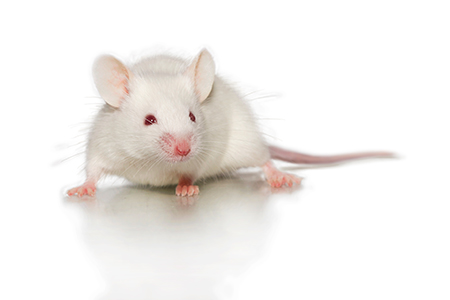 COVID-19 modeling in mice has been limited by species differences in the ACE2 protein between mice and humans. The SARS-CoV-2 virus uses the ACE2 protein to facilitate entry into cells. The mouse ACE2 receptor is not permissive for viral binding, and thus initial reports indicate that wild type mice cannot be infected with SARS-CoV-2 1,2.
COVID-19 modeling in mice has been limited by species differences in the ACE2 protein between mice and humans. The SARS-CoV-2 virus uses the ACE2 protein to facilitate entry into cells. The mouse ACE2 receptor is not permissive for viral binding, and thus initial reports indicate that wild type mice cannot be infected with SARS-CoV-2 1,2. One approach to overcoming this challenge is the use of transgenic mice expressing human ACE2, but access to these models is limited to date. But two recent preprints describe alternate solutions which may dramatically accelerate COVID-19 mouse studies.
Mouse-adapted viruses can improve infectivity and disease severity
Small animal models of disease offer many advantages to researchers, but the species-tropism of some infectious diseases limit their application. One method that has been applied to many types of viral illnesses is generation of a mouse-adapted virus. For respiratory viruses, this is commonly done via serial lung-to-lung passages in mice, which may increase both viral replication as well as viral pathogenicity. Two groups applied a mouse adaptation strategy to SARS-CoV-2, though with slightly different tactics.Mouse-adapted SARS-CoV-2 strains can infect wild type mice
Gu et al. used traditional serial passaging in BALB/c mice to develop a viral strain, MASCp6, which efficiently infected wild type mice. Using aged BALB/c as the host, they serially passaged a SARS-CoV-2 clinical isolate from Wuhan, China. Following intranasal inoculation, viral RNA was present in lung homogenate three days post-infection. This lung homogenate (P0) was used for intranasal inoculation into new hosts for the next passage and so on for six passages to generate MASCp6. Sequence analysis indicated four non-synonymous mutations, including one in the spike protein receptor binding domain (RBD) which may act to increase the binding affinity between SARS-CoV-2 spike and murine ACE23.Both young (6 week old) and aged (9 month old) BALB/c mice displayed viral replication across a range of tissues after infection with MASCp6. Whereas only aged BALB/c mice lost weight post-infection, both young and aged mice developed mild to moderate pneumonia. Aged mice displayed more severe lung damage and inflammation3.
Gu et al. used a subunit vaccine comprised of SARS-CoV-2 spike protein RBD fused to human IgG Fc in a proof of concept study to demonstrate the use of MASCp6-infected mice for vaccine efficacy studies. Following MASCp6 challenge, viral RNA was undetectable in the lung and trachea of immunized mice compared to wild mice, which had high viral RNA levels. Immunization prevented lung damage by the mouse-adapted virus3.
Rational genetic re-engineering
Dinnon, Leist and coworkers took another approach to developing a mouse-adapted virus: reverse genetics. After analyzing which protein residues in the RBD of several coronaviruses capable of infecting mice interacted with ACE2 and comparing to the SARS-CoV-2 protein sequence, the researchers identified residue 498 as divergent. Molecular modeling lent evidence to the theory that Q498 of SARS-CoV-2 may have reduced interaction with ACE2 and thus lower binding affinity. They thus substituted Q498 and neighboring residue P499 with the versions found in SARS-CoV and another coronavirus, WIV1, capable of infecting mice. The resulting recombinant viral strain was designated SARS-CoV-2 MA4.The mutant SARS-CoV-2 MA strain infected young (12 weeks old) BALB/c mice and replicated in vivo, whereas no viral replication was seen in mice after infection with the parent SARS-CoV-2 virus. Mice infected with SARS-CoV-2 MA developed airway inflammation and reduced pulmonary function and essentially mild to moderate disease. 12 month old BALB/c mice developed transient weight loss, prolonged viral replication in some mice, increased inflammation and more significant pulmonary function loss compared to young mice4. The more severe disease phenotype is reminiscent of the increased mortality with age in humans affected by COVID-19.
Using a Venezuelan equine encephalitis virus replicon particle (VRP) system, the researchers vaccinated BALB/c mice against the spike or nucleocapsid proteins of SARS-CoV-2. Vaccination against spike, but not nucleocapsid, protected mice and resulted in lower viral replication post-challenge with SARS-CoV-2 MA. Dinnon, Leist et al. also demonstrated both prophylactic and therapeutic efficacy of pegylated interferon lambda-1 against SARS-CoV-2 MA using this system4.
The door is open to an explosion of COVID-19 research
The fight against COVID-19 has been hampered by the lack of mouse models for the disease. The development of mouse-adapted SARS-CoV-2 virus strains puts the mouse back in the ring. When mouse-adapted SARS-CoV-2 viruses become widely available, standard strains of laboratory mice such as BALB/c and C57BL/6 which are readily available in almost any quantity worldwide can be used in COVID-19 studies. These mouse strains are relatively inexpensive, and in conjunction with mouse-adapted viruses, can fill the gap until transgenic hACE2 mice are widely available. Mouse-adapted viruses open the door to high-throughput screening of potential COVID-19 therapeutics and vaccine candidates.One final note: while mouse-adapted SARS-CoV-2 strains are undoubtedly a major advance, these modified viruses may not completely reflect all aspects of the original human-tropic virus. Thus there is likely an important role for both experimental systems (wild type mice + mouse-adapted SARS-CoV-2 and hACE2 mice + SARS-CoV-2 clinical isolates) in the critical preclinical research to come.
- Transgenic hACE2 mice for SARS-CoV-2 and COVID-19
- An Overview of Mouse Models for COVID-19
- Safety Testing Critical for COVID-19 Therapies and Vaccines
- Knockout Mice for the Study of Coronavirus Infections
- Aged Inbred Mice May Advance Research Into Age-Related Mortality in Coronavirus Infections















.jpg)

.jpg)
.jpg)
.jpg)
.jpg)





.jpg)


.jpg)
.jpg)

.jpg)


.jpg)





.jpg)

.jpg)




